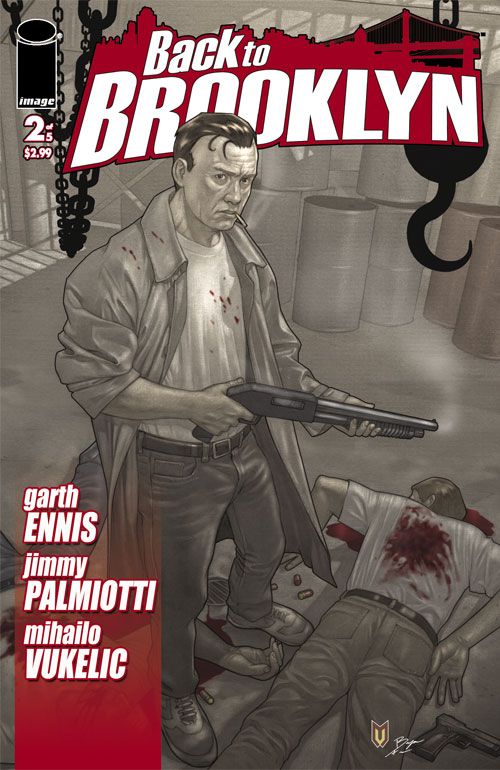“Back to Brooklyn” #2 brings to mind the dreaded and fashionable M-word of current comic criticism and review: mediocre. It’s become the premier manner of insulting a comic book recently to call it mediocre, but, really, all it means is that the book in question is middle-of-the-road in quality. Not quite good, not quite bad, just a by-the-numbers comic book; in essence, “Back to Brooklyn” #2.
Paul Saetta runs Brooklyn and his brother Bob used to be his number two man until he decided to turn Paul over to the police. In response, Paul kidnapped Bob’s wife and son, and now Bob needs to gather evidence to use a leverage to get his family back. It’s not a bad premise, but this issue is still in set-up mode as Bob collects his old girlfriend and childhood friend to protect them from the inevitable fall-out from his war on his brother. They even visit the old deli where they hung out as kids and get the owner to help them. Though not terribly original, you would think the writing of Garth Ennis and Jimmy Palmiotti should raise it above the cliche, but it doesn’t.
We’re never told explicitly what Paul has done to warrant his brother’s betrayal, but Bob suggests it’s something very bad and we get hints that it involves working with Russian gangsters who act as slavers. While horrendous, it does raise the question of why this particular action so offends Bob. That question is the one thing that redeems this comic and suggests that it may yet rise above its current lackluster quality. Bob’s old flame puts the question into focus by mocking Bob’s suggestion that he was, and is, a soldier, when all she saw was a thug who wrapped himself up in concepts of honor, loyalty and male bravado. Where does one draw the line between “honorable” and “dishonorable” criminal activities?
However, most of the comic is a by-the-numbers story of Bob and Paul each making moves to take the other one down with everyone between them pawns to use to their advantage. The dialogue has the odd humorous line, but is not up to the quality Ennis usually delivers. Mihailo Vukelic’s art is competent and has a genuine realistic feel to it, but his characters are often stuff and lifeless. His close-ups are very attractive and well done, but the further the perspective gets from characters, the more stiff and awkward they look. His colors, though, give the book a unique feel with muted tones and a painted look.
Ennis and Palmiotti do get things right in making “Back to Brooklyn” #2 very new-reader friendly and explains everything someone who missed the first issue would need to know to follow along. Sadly, the plot isn’t likely to keep said new reader engaged, or make him or her want to read issue three.

